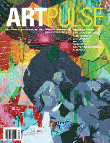« Reviews
Melanie Smith and Rafael Ortega: Parres Trilogy

Melanie Smith and Rafael Ortega. Parres II, 2004. 35 mm transfer to video. 4:20 minutes. Courtesy of gallery OMR, Mexico and Galerie Peter Kilchmann, Zurich
By Bryan Barcena
The loss of the Miami Art Central or MAC’s exhibition space was seen by many as the passing of a forward-thinking and novel institution from the cultural landscape of the area. However, the pioneering spirit of the museum lives on through MAC’s partnership with the Miami Art Museum and the dedication of its curator and director, Rina Carvajal. Ms. Carvajal continues to bring daring new work to the forefront with her latest exhibition: “Melanie Smith with Rafael Ortega: Parres Trilogy” shown March 6 to June 29 at the Miami Art Museum.
Melanie Smith is beyond doubt an artist who has used her adopted environment as both a conceptual and aesthetic inspiration. The English-born artist has lived in the sprawling metropolis of Mexico City for the last twenty years, and her interest in the dually banal and chaotic experience of the 21st Century city is evident in her artistic output. Smith’s oeuvre has been inspired by the density of information and stimuli received and processed by each city dweller on a daily basis. She attempts to present the observer with the remnants of a shared urban experience, encouraged by themes as diverse as the over-abundance of cheap consumable goods at the communal market ‘Tianguis,’ or through her video pieces that seek to re-imagine the layout of the city as an abstracted pictorial space.
Visitors are introduced to the exhibition in a room sparsely inhabited by two installation pieces. Immediately apparent to the viewer is the monumental concrete wall set a few feet apart from the museum’s wall. The monolithic piece entitled “Installation for Parres 15″ dominates the room, and it is only apparent by walking around the wall that behind it is a medium size canvas seemingly inhabited by grey boxes. However, it is impossible to view the canvas in its entirety. Blocked by the massive wall, the viewer is only able to glimpse the painting from an extreme angle. The wall becomes a frustrating obstruction to the images we would traditionally seek to observe in a museum setting. On an opposite wall is the piece “Negative Painting.” A haphazardly spray painted grey frame against the blank white wall highlights the absence of image. Recalling the conceptual frames that jutted out towards the viewer made by Eva Hesse during the 1960’s, “Negative Painting” is a conceptual exercise working in tandem with its adjacent wall. Smith’s juxtaposition of seen and unseen is indeed setting the tone for the exhibition. The artist is in control. She chooses to selectively obstruct and reveal elements of her work to the viewer and creates a staging for the process that takes place within the “Parres Trilogy” videos.
The “Parres Trilogy” opening sequence introduces the viewer to the setting for the three videos. We are greeted by a landscape that could be confused with that of shantytowns on the outskirts of many a third-world city. Smith describes the Parres as a transient place that “always struck me as being a very desolate and sad place, because it has no center.” In the distance, the bare concrete and sparingly painted walls of the town, arranged in successive ascending levels, can be seen as a figure walks towards the viewer. The subject then stops a few feet away from the camera and paints the screen in sweeping motions with cream-colored spray paint. The man continues this action until the screen is completely opaque. The monochromatic screen at that moment begins to take on a very painterly quality. The process of destroying the landscape through paint creates a flat canvas reminiscent of abstract minimalist paintings such as those by Jules Olitski. The viewer is then left to ruminate on the newly created canvas for a few seconds before the video fades to black.
“Parres II” is a departure from the other two videos in the series, while still maintaining the same conceptual concerns. The video zooms away from a macro shot of Smith, revealing her surroundings; she now stands in the middle of Parres, surrounded by meager homes and horses. Positioned in the middle of the road, the artist bears a confused, anxious expression that remains unchanged throughout the duration of the video. As rain begins to fall, the camera continues to zoom away from the artist who remains frozen. The rain eventually becomes strong enough to obscure the camera in a wash of white. As the video winds to an end, the rain slows its descent as the scene is restored.
The third video in the series is essentially a reverse of the first. A completely gray screen is broken by the hand of a man sponging away the paint that obscures our vision, thereby revealing the desolate landscape of Parres. As the coat is washed away, it is apparent that the setting is the same as Parres I. The water washing away the impediment inverts the process and our landscape is restored. Upon finishing his effort, the man strolls away from the camera and towards the town; the “Parres” video trilogy is then complete.
The “Parres Trilogy” highlights Smith and Ortega’s ability to merge the conceptual in their work with striking images that linger in the mind of the viewer. Smith’s capacity to obscure and disclose images is an attempt not at demystifying the practice, but instead at expanding the possibilities of expression and the ways that visual information can be interpreted by the viewer. Smith notes that her work makes an effort to “set up a fiction which goes back to my interest in setting up a dialogue between abstraction and the ‘real’”. What Parres offers viewers is a chance to pull back a curtain. Smith and Ortega ask us to examine the ways in which we can communicate, showing us that the ability to conceal can be equally as powerful as the ability to reveal.
Filed Under: Reviews


































